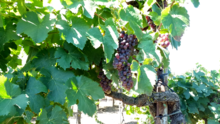| Aramon | |
|---|---|
| Grape (Vitis) | |
 Old grape in Bessan, southern France | |
| Color of berry skin | Noir |
| Species | Vitis vinifera |
| Also called | Aramon noir, Burchardt's Prince, Burkhardt, Pisse-Vin, Ugni noir |
| Origin | Spain or southern France? |
| Notable regions | Languedoc-Roussillon |
| Hazards | Sensitive to spring frost |
| VIVC number | 544 |
Aramon or Aramon noir is a variety of red wine grape grown primarily in Languedoc-Roussillon in southern France. Between the late 19th century and the 1960s, it was France's most grown grape variety, but plantings of Aramon have been in continuous decline since the mid-20th century. Aramon has also been grown in Algeria, Argentina and Chile but nowhere else did it ever reach the popularity it used to have in the south of France.[1]
It is most noted for its very high productivity, and yields can reach levels as high as 400 hectolitres per hectare.[1] The vine's resistance to oidium, phylloxera, and powdery mildew led to its reputation as workhorse grape that could be relied on by growers for dependable financial returns.[2] However, when cropped at high yields, the resultant wines are very light red in color (but show a blue-black tinge), low in alcohol and extract and generally thin on character.[1] Such Aramon wine is often blended with wine from grapes of darker color such as Alicante Bouschet and Grand Noir de la Calmette to darken the resulting wine.[2]
If planted on poor soils and pruned very severely to much smaller yields, it has been shown to be able to give concentrated wines with spicy, earthy, herbaceous, and somewhat rustic character.[3] However, such Aramon wines are extremely rare, but some varietal wine is still produced in Languedoc.
A viticultural drawback of Aramon is that it buds early and ripens late, which means that it only is suitable for growing in hotter regions, and that it is very sensitive to spring frost.[1]
- ^ a b c d Jancis Robinson, ed. (2006). "Aramon". Oxford Companion to Wine (Third ed.). Oxford: Oxford University Press. pp. 28. ISBN 0-19-860990-6.
- ^ a b J. Robinson Vines, Grapes & Wines pg 205 Mitchell Beazley 1986 ISBN 1-85732-999-6
- ^ Oz Clarke Encyclopedia of Grapes Harcourt Books 2001 ISBN 0-15-100714-4